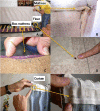Bedbugs and infectious diseases
- PMID: 21288844
- PMCID: PMC3060893
- DOI: 10.1093/cid/ciq102
Bedbugs and infectious diseases
Abstract
Bedbugs are brown and flat hematophagous insects. The 2 cosmopolite species, Cimex lectularius and Cimex hemipterus, feed on humans and/or domestic animals, and recent outbreaks have been reported in occidental countries. Site assessment for bedbug eradication is complex but can be assured, despite emerging insecticide resistance, by hiring a pest-control manager. The common dermatological presentation of bites is an itchy maculopapular wheal. Urticarial reactions and anaphylaxis can also occur. Bedbugs are suspected of transmitting infectious agents, but no report has yet demonstrated that they are infectious disease vectors. We describe 45 candidate pathogens potentially transmitted by bedbugs, according to their vectorial capacity, in the wild, and vectorial competence, in the laboratory. Because of increasing demands for information about effective control tactics and public health risks of bedbugs, continued research is needed to identify new pathogens in wild Cimex species (spp) and insecticide resistance.
Figures





Comment in
-
Bedbugs and transmission of Trypanosoma cruzi.Clin Infect Dis. 2011 Jul 15;53(2):210; author reply 210-1. doi: 10.1093/cid/cir342. Clin Infect Dis. 2011. PMID: 21690635 No abstract available.
-
Bedbugs and vector-borne diseases.Clin Infect Dis. 2014 Nov 1;59(9):1351-2. doi: 10.1093/cid/ciu575. Epub 2014 Jul 16. Clin Infect Dis. 2014. PMID: 25034425 No abstract available.
References
-
- Usinger RL. Monograph of Cimicidae (Hemiptera–Heteroptera) Vol 7. College Park, MD: Entomological Society of America; 1966. p. 50.
-
- Gbakima AA, Terry BC, Kanja F, Kortequee S, Dukuley I, Sahr F. High prevalence of bedbugs Cimex hemipterus and Cimex lectularius in camps for internally displaced persons in Freetown, Sierra Leone: a pilot humanitarian investigation. West Afr J Med. 2002;21:268–71. - PubMed
-
- Heymann WR. Bed bugs: a new morning for the nighttime pests. J Am Acad Dermatol. 2009;60:482–3. - PubMed
Publication types
MeSH terms
LinkOut - more resources
Full Text Sources
Medical
Miscellaneous

